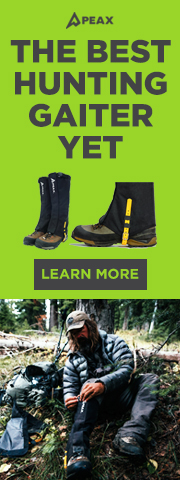BuckyHunter13
New member
- Jul 6, 2014
- 41
A lot of guys, myself included, don?t get to hunt elk often enough to maximize the education elk so readily provide. Elk hunting for 10-12 days straight always leave me with tons of questions and not enough time to answer them from one day to the next. I can sometimes answer my own questions while reflecting on a day or a sequence of encounters. I thought it might be beneficial (for me or anyone else newer to elk hunting) to share a sequence of hunts from this past year. I will post 3 specific days that fit together neatly along with relevant information from other days.
August 31 (Day 3) ?
Weather: 40 overnight, 70 by 10AM, Wind: 15mph, NE-> NW
Elevation: 9600 to 10,200
Conditions/Background: No bugling, dry conditions, warm. Heavily pressured OTC Unit. It?s the Friday heading into Labor Day weekend. With the holiday came a noticeable increase in hunting pressure/generators/trucks on the forest roads. We spent part of the day before hunting to the north and west of ?Bedded Bulls? but the sign was very light. We?ve had early encounters in this area in the past and I know there?s cow bedding in the same general area as the ?Bedded Bulls? waypoint.
The Hunt: We began our morning downhill from ?Bedded Bulls?. My thinking was that they may be working their way up from some of the smaller parks as they had in previous years. With us approaching from the North with a NE wind, I thought it was better to approach further down the mountain and work our way uphill as we tried to locate elk to the South (or wherever we found them). This entry spot felt like a location most guys wouldn?t use due to the terrain which appealed to me. We finally reached the open draw (not exactly a park but for all intents and purposes, a park) around 7:30. We began working our way back up the hill slowly, lightly calling occasionally and looking for fresh sign in the various pockets of pines. At one point I heard what sounded like glunking from above us (North of the X). I called a few times and heard what sounded almost like a nervous grunt but not quite. I tried to turn up the urgency of the calling but stuck mainly to cow calls. After a while it was clear my calling had been dismissed. Giving chase was not an option due to the terrain. (Very steep, a mix of areas of loose rock and open mature dark timber? Open/loud/steep to the point of unsafe.) We continued up the edge of the open draw until there was an area to cross to the South under some cover. Sign was decent in spots but nothing overwhelming. We worked our way south then up the hill west. We smelled elk in spots and found sign that looked comparatively fresh, but nothing said ?there?s an elk around the corner.? Continued calling and moving up. At this point I figured the elk would be above us, but nothing turned up.
We decided to start hunting our way back to the truck around 10:15. I thought it would be worth detouring through a bedding area from prior years. We worked our way back north, crossed the open draw working our way up hill. We were 10 yards inside the dark timber on the north side of the draw when we hit really fresh sign (shiny fresh poop). We stopped for a second before continuing on at a crawling pace. We had gone another 10 yards when a really nice bull exploded out of his bed 25-30 yards in front of us. He was tucked in to a thickly screened area. I could make him out from the shoulders up as he crashed away. I immediately let out a nervous grunt and he stopped out of sight about 50-60 yards away. I did some light cow calling and transitioned to more urgent pleading calls and turned away to let a bugle rip. I could hear him pacing out of sight, maybe 70 yards away? About this point I saw a smaller bull skirting us 25 yards to the west, headed south. I was pretty sure he was trying to catch our wind. By this point my dad had dropped 20-30 yards south of me, so I thought that bull could be in play (if he was legal, which I think he was). After 5-10 minutes we both lost sight of him (it was really thick in spots). I?m pretty sure he left to the South. I re-focused on the bigger bull once I lost sight of him. I alternated between quiet spells and calling though I wasn?t sure if he was still there. I eventually resorted to the kitchen sink method of calling. Within 10 minutes of going quiet I heard the big bull trotting up the hill to the West. Excitement over.
At this point part of me felt vindicated for "my area" because we basically did find the bulls. Another part of me felt like I just blew our best chance for the entire trip. One of these was more accurate than the other.
My takeaways?
One of the biggest errors was that my mindset had shifted to ?hunting?s over, back to the truck?. Even though I consciously told myself to hunt hard all the way through, it was difficult to shift all the way back to the deliberate I?ve-got-all-day mindset necessary for the situation. If I had been better focused I might have put the puzzle together before taking another step past the fresh poop. Elk heading this way hours earlier? historical bedding location? fresh poop. In retrospect it shouldn?t have been a surprise that I damn near stepped on them.
A second takeaway was the impact of overall attitude. Hunting quiet elk is hard. It's hard to maintain the confidence and behave with the expectation that elk really are 30 yards ahead. Especially when you're hot, exhausted, and getting frustrated at the overall lack of sign. You're wondering what's changed... is it the people pressure, the heat, the dry weather?
Last observation... I know a lot of guys think they have to go 2-4 miles deep before it even counts as hunting. The loop we made this morning was roughly 4 miles. We've had as many encounters within a half mile of the road as we have 4 miles deep. Maybe it's dumb luck, but sometimes it's finding the right corridor, pocket, or unconventional access point. This is probably more applicable to early season before the bugling starts in earnest. I can't imagine the elk survival handbook says bugling near a road makes for easy living.
My questions?
Did I bump them out of the area? If so, when will they be back? How far did they go? Why is there so little sign in areas that have held elk in the past? What would you have done differently? Where are the rest of the elk?
About the map...
Yellow is roughly where I heard the glunking. Red dotted line is assumed route of travel. Map has been photoshopped to obscure the location.
August 31 (Day 3) ?
Weather: 40 overnight, 70 by 10AM, Wind: 15mph, NE-> NW
Elevation: 9600 to 10,200
Conditions/Background: No bugling, dry conditions, warm. Heavily pressured OTC Unit. It?s the Friday heading into Labor Day weekend. With the holiday came a noticeable increase in hunting pressure/generators/trucks on the forest roads. We spent part of the day before hunting to the north and west of ?Bedded Bulls? but the sign was very light. We?ve had early encounters in this area in the past and I know there?s cow bedding in the same general area as the ?Bedded Bulls? waypoint.
The Hunt: We began our morning downhill from ?Bedded Bulls?. My thinking was that they may be working their way up from some of the smaller parks as they had in previous years. With us approaching from the North with a NE wind, I thought it was better to approach further down the mountain and work our way uphill as we tried to locate elk to the South (or wherever we found them). This entry spot felt like a location most guys wouldn?t use due to the terrain which appealed to me. We finally reached the open draw (not exactly a park but for all intents and purposes, a park) around 7:30. We began working our way back up the hill slowly, lightly calling occasionally and looking for fresh sign in the various pockets of pines. At one point I heard what sounded like glunking from above us (North of the X). I called a few times and heard what sounded almost like a nervous grunt but not quite. I tried to turn up the urgency of the calling but stuck mainly to cow calls. After a while it was clear my calling had been dismissed. Giving chase was not an option due to the terrain. (Very steep, a mix of areas of loose rock and open mature dark timber? Open/loud/steep to the point of unsafe.) We continued up the edge of the open draw until there was an area to cross to the South under some cover. Sign was decent in spots but nothing overwhelming. We worked our way south then up the hill west. We smelled elk in spots and found sign that looked comparatively fresh, but nothing said ?there?s an elk around the corner.? Continued calling and moving up. At this point I figured the elk would be above us, but nothing turned up.
We decided to start hunting our way back to the truck around 10:15. I thought it would be worth detouring through a bedding area from prior years. We worked our way back north, crossed the open draw working our way up hill. We were 10 yards inside the dark timber on the north side of the draw when we hit really fresh sign (shiny fresh poop). We stopped for a second before continuing on at a crawling pace. We had gone another 10 yards when a really nice bull exploded out of his bed 25-30 yards in front of us. He was tucked in to a thickly screened area. I could make him out from the shoulders up as he crashed away. I immediately let out a nervous grunt and he stopped out of sight about 50-60 yards away. I did some light cow calling and transitioned to more urgent pleading calls and turned away to let a bugle rip. I could hear him pacing out of sight, maybe 70 yards away? About this point I saw a smaller bull skirting us 25 yards to the west, headed south. I was pretty sure he was trying to catch our wind. By this point my dad had dropped 20-30 yards south of me, so I thought that bull could be in play (if he was legal, which I think he was). After 5-10 minutes we both lost sight of him (it was really thick in spots). I?m pretty sure he left to the South. I re-focused on the bigger bull once I lost sight of him. I alternated between quiet spells and calling though I wasn?t sure if he was still there. I eventually resorted to the kitchen sink method of calling. Within 10 minutes of going quiet I heard the big bull trotting up the hill to the West. Excitement over.
At this point part of me felt vindicated for "my area" because we basically did find the bulls. Another part of me felt like I just blew our best chance for the entire trip. One of these was more accurate than the other.
My takeaways?
One of the biggest errors was that my mindset had shifted to ?hunting?s over, back to the truck?. Even though I consciously told myself to hunt hard all the way through, it was difficult to shift all the way back to the deliberate I?ve-got-all-day mindset necessary for the situation. If I had been better focused I might have put the puzzle together before taking another step past the fresh poop. Elk heading this way hours earlier? historical bedding location? fresh poop. In retrospect it shouldn?t have been a surprise that I damn near stepped on them.
A second takeaway was the impact of overall attitude. Hunting quiet elk is hard. It's hard to maintain the confidence and behave with the expectation that elk really are 30 yards ahead. Especially when you're hot, exhausted, and getting frustrated at the overall lack of sign. You're wondering what's changed... is it the people pressure, the heat, the dry weather?
Last observation... I know a lot of guys think they have to go 2-4 miles deep before it even counts as hunting. The loop we made this morning was roughly 4 miles. We've had as many encounters within a half mile of the road as we have 4 miles deep. Maybe it's dumb luck, but sometimes it's finding the right corridor, pocket, or unconventional access point. This is probably more applicable to early season before the bugling starts in earnest. I can't imagine the elk survival handbook says bugling near a road makes for easy living.
My questions?
Did I bump them out of the area? If so, when will they be back? How far did they go? Why is there so little sign in areas that have held elk in the past? What would you have done differently? Where are the rest of the elk?
About the map...
Yellow is roughly where I heard the glunking. Red dotted line is assumed route of travel. Map has been photoshopped to obscure the location.



